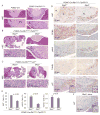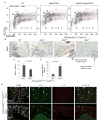Skp2 deletion unmasks a p27 safeguard that blocks tumorigenesis in the absence of pRb and p53 tumor suppressors
- PMID: 24229711
- PMCID: PMC3880806
- DOI: 10.1016/j.ccr.2013.09.021
Skp2 deletion unmasks a p27 safeguard that blocks tumorigenesis in the absence of pRb and p53 tumor suppressors
Abstract
pRb and p53 are two major tumor suppressors. Here, we found that p53 activates expression of Pirh2 and KPC1, two of the three ubiquitin ligases for p27. Loss of p53 in the absence of Skp2, the third ubiquitin ligase for p27, shrinks the cellular pool of p27 ubiquitin ligases to accumulate p27 protein. In the absence of pRb and p53, p27 was unable to inhibit DNA synthesis in spite of its abundance, but could inhibit division of cells that maintain DNA replication with rereplication. This mechanism blocked pRb/p53 doubly deficient pituitary and prostate tumorigenesis lastingly coexistent with bromodeoxyuridine-labeling neoplastic lesions, revealing an unconventional cancer cell vulnerability when pRb and p53 are inactivated.
Copyright © 2013 Elsevier Inc. All rights reserved.
Figures








Similar articles
-
Distinct outcomes from targeted perturbations of the multi-subunit SCFSkp2 E3 ubiquitin ligase in blocking Trp53/Rb1-null prostate tumorigenesis.Commun Biol. 2025 Feb 22;8(1):278. doi: 10.1038/s42003-025-07662-3. Commun Biol. 2025. PMID: 39987265 Free PMC article.
-
p27T187A knockin identifies Skp2/Cks1 pocket inhibitors for advanced prostate cancer.Oncogene. 2017 Jan 5;36(1):60-70. doi: 10.1038/onc.2016.175. Epub 2016 May 16. Oncogene. 2017. PMID: 27181203 Free PMC article.
-
Skp2 is required for survival of aberrantly proliferating Rb1-deficient cells and for tumorigenesis in Rb1+/- mice.Nat Genet. 2010 Jan;42(1):83-8. doi: 10.1038/ng.498. Epub 2009 Dec 6. Nat Genet. 2010. PMID: 19966802 Free PMC article.
-
Racing to block tumorigenesis after pRb loss: an innocuous point mutation wins with synthetic lethality.Cell Cycle. 2010 Jun 1;9(11):2118-23. doi: 10.4161/cc.9.11.11726. Epub 2010 Jun 1. Cell Cycle. 2010. PMID: 20505340 Free PMC article. Review.
-
Antitumor mechanisms when pRb and p53 are genetically inactivated.Oncogene. 2015 Aug 27;34(35):4547-57. doi: 10.1038/onc.2014.399. Epub 2014 Dec 8. Oncogene. 2015. PMID: 25486431 Free PMC article. Review.
Cited by
-
Roles of F-box proteins in cancer.Nat Rev Cancer. 2014 Apr;14(4):233-47. doi: 10.1038/nrc3700. Nat Rev Cancer. 2014. PMID: 24658274 Free PMC article. Review.
-
[Progress on correlation between cell senescence and idiopathic pulmonary fibrosis].Zhejiang Da Xue Xue Bao Yi Xue Ban. 2019 May 25;48(1):111-115. doi: 10.3785/j.issn.1008-9292.2019.02.16. Zhejiang Da Xue Xue Bao Yi Xue Ban. 2019. PMID: 31102365 Free PMC article. Review. Chinese.
-
Flavokawain A induces deNEDDylation and Skp2 degradation leading to inhibition of tumorigenesis and cancer progression in the TRAMP transgenic mouse model.Oncotarget. 2015 Dec 8;6(39):41809-24. doi: 10.18632/oncotarget.6166. Oncotarget. 2015. PMID: 26497688 Free PMC article.
-
SKP2 Knockout in Rb1/p53-Deficient Mouse Models of Osteosarcoma Induces Immune Infiltration and Drives a Transcriptional Program with a Favorable Prognosis.Mol Cancer Ther. 2024 Feb 1;23(2):223-234. doi: 10.1158/1535-7163.MCT-23-0173. Mol Cancer Ther. 2024. PMID: 37871911 Free PMC article.
-
[Targeting Cullin-RING E3 ligases for anti-cancer therapy: efforts on drug discovery].Zhejiang Da Xue Xue Bao Yi Xue Ban. 2020 May 25;49(1):1-19. doi: 10.3785/j.issn.1008-9292.2020.02.21. Zhejiang Da Xue Xue Bao Yi Xue Ban. 2020. PMID: 32621419 Free PMC article. Review. Chinese.
References
-
- Arias EE, Walter JC. Strength in numbers: preventing rereplication via multiple mechanisms in eukaryotic cells. Genes Dev. 2007;21:497–518. - PubMed
-
- Balthasar N, Coppari R, McMinn J, Liu SM, Lee CE, Tang V, Kenny CD, McGovern RA, Chua SC, Jr, Elmquist JK, et al. Leptin receptor signaling in POMC neurons is required for normal body weight homeostasis. Neuron. 2004;42:983–891. - PubMed
MeSH terms
Substances
Grants and funding
LinkOut - more resources
Full Text Sources
Other Literature Sources
Medical
Molecular Biology Databases
Research Materials
Miscellaneous

